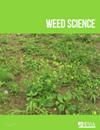高温提高抗性掌叶苋2,4-D代谢
IF 2.1
2区 农林科学
Q2 AGRONOMY
引用次数: 0
摘要
摘要苋菜(Amaranthus palmeri S. Watson)在美国的几个种植系统中是一种麻烦的杂草。对多种除草剂的抗性演变是该杂草管理的一个挑战。最近,我们报道了6路抗性a . palmeri群体(KCTR)对2,4- d的代谢抗性可能是由细胞色素P450 (P450)活性介导的。植物生长温度会影响除草剂的药效和抗性水平。温度对棕榈芽孢杆菌2,4- d抗性的影响尚不清楚。在本研究中,我们研究了KCTR和已知易感(MSS) a . palmeri在低温(LT, 24/14℃,昼/夜[d/n])和高温(HT, 34/24℃,d/n)条件下对2,4- d的反应。当MSS和KCTR植株高8 ~ 10 cm时,分别用0、140、280、560(田间推荐剂量)、1120和2240 g / ha处理2,4- d。此外,在低温和高温下生长的8- 10厘米高的MSS和KCTR植株也处理了[14C]2,4- d,以评估低温和高温下2,4- d的代谢。剂量效应实验结果表明,KCTR A. palmeri在高温下对2,4- d的抗性比MSS高23倍。然而,在LT时,KCTR对2,4- d的抗性仅比MSS高2倍。重要的是,与对照组相比,高温下KCTR和MSS A. palmeri体内2,4- d的代谢增强。此外,用P450抑制剂马拉硫磷治疗后,再用2,4- d治疗,增加了KCTR在高温下的敏感性。总的来说,与低温相比,高温下2,4- d的快速代谢增加了KCTR对2,4- d的抗性。因此,在温度较低时施用2,4- d可以改善对2,4- d抗性的控制。本文章由计算机程序翻译,如有差异,请以英文原文为准。
High Temperature Increases 2,4-D Metabolism in Resistant Amaranthus palmeri
Abstract Palmer amaranth (Amaranthus palmeri S. Watson) is a troublesome weed in several cropping systems in the United States. The evolution of resistance to multiple herbicides is a challenge for the management of this weed. Recently, we reported metabolic resistance to 2,4-D possibly mediated by cytochrome P450 (P450) activity in a six-way-resistant A. palmeri population (KCTR). Plant growth temperature can influence the herbicide efficacy and level of resistance. The effect of temperature on 2,4-D resistance in A. palmeri is unknown. In the present research, we investigated the response of KCTR and a known susceptible (MSS) A. palmeri response to 2,4-D grown under low-temperature (LT, 24/14 C, day/night [d/n]) or high-temperature (HT, 34/24 C, d/n) regimes. When MSS and KCTR plants were 8- to 10-cm tall, they were treated with 0, 140, 280, 560 (field recommended dose), 1,120, and 2,240 g ai ha–1 of 2,4-D. Further, 8- to 10-cm-tall MSS and KCTR plants grown at LT and HT were also treated with [14C]2,4-D to assess the metabolism of 2,4-D at LT and HT. The results of dose–response experiments suggest that KCTR A. palmeri exhibits 23 times more resistance to 2,4-D at HT than MSS. Nonetheless, at LT, the resistance to 2,4-D in KCTR was only 2-fold higher than in MSS. Importantly, there was enhanced metabolism of 2,4-D in both KCTR and MSS A. palmeri at HT compared with LT. Further, treatment with the P450 inhibitor malathion, followed by 2,4-D increased the susceptibility of KCTR at HT. Overall, rapid metabolism of 2,4-D increased KCTR resistance to 2,4-D at HT compared with LT. Therefore, the application of 2,4-D when temperatures are cooler can improve control of 2,4-D–resistant A. palmeri.
求助全文
通过发布文献求助,成功后即可免费获取论文全文。
去求助
来源期刊

Weed Science
农林科学-农艺学
CiteScore
4.60
自引率
12.00%
发文量
64
审稿时长
12-24 weeks
期刊介绍:
Weed Science publishes original research and scholarship in the form of peer-reviewed articles focused on fundamental research directly related to all aspects of weed science in agricultural systems. Topics for Weed Science include:
- the biology and ecology of weeds in agricultural, forestry, aquatic, turf, recreational, rights-of-way and other settings, genetics of weeds
- herbicide resistance, chemistry, biochemistry, physiology and molecular action of herbicides and plant growth regulators used to manage undesirable vegetation
- ecology of cropping and other agricultural systems as they relate to weed management
- biological and ecological aspects of weed control tools including biological agents, and herbicide resistant crops
- effect of weed management on soil, air and water.
 求助内容:
求助内容: 应助结果提醒方式:
应助结果提醒方式:


